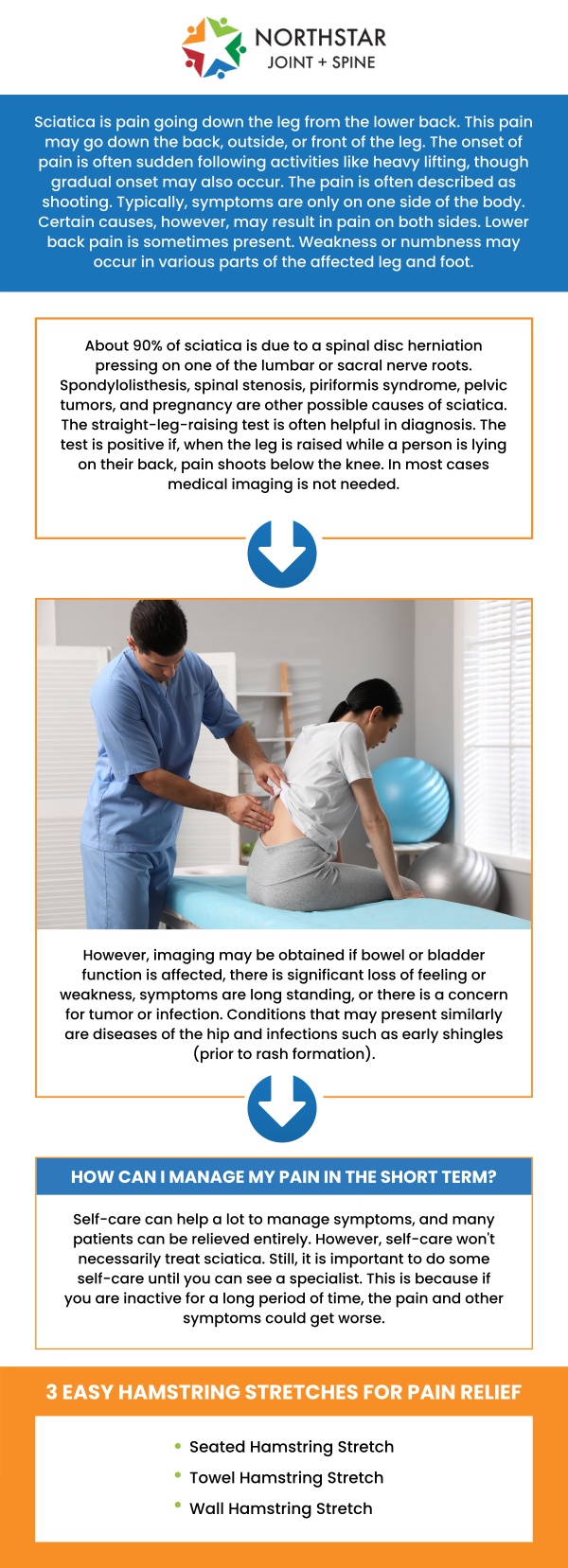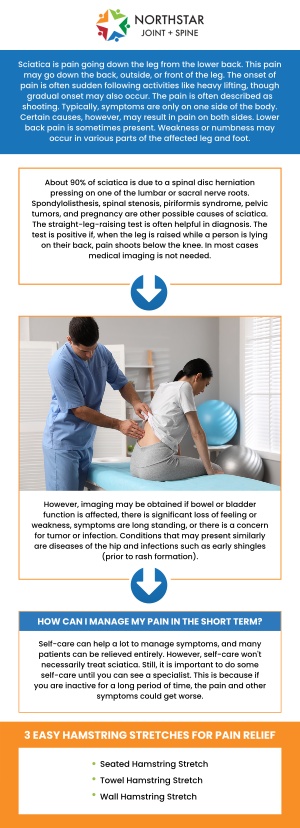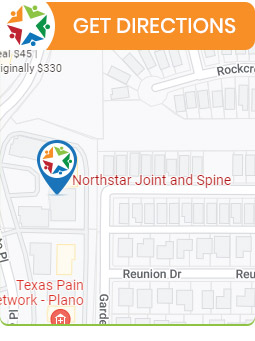How Is Sciatica Pain Diagnosed?
Sciatica pain is diagnosed through a thorough physical examination and detailed medical history review, where Board-Certified Dr. Robert J. Nocerini, MD, evaluates your symptoms, activities, and any potential triggers. Neurological tests help assess nerve involvement. If needed, imaging tests like MRI or CT scans offer a clearer picture of the underlying causes, such as herniated discs or spinal stenosis, to guide effective treatment at Northstar Joint and Spine. For more information contact us today or schedule an appointment online. We are conveniently located at 7704 San Jacinto Pl Suite #200 Plano, TX 75024.


Table of Contents:
How does a doctor confirm if pain is from sciatica?
How do doctors identify the cause of sciatica pain?
Is medical history important in diagnosing sciatica?
Is it normal for sciatica pain to come and go?
Why Choose Board-Certified Dr. Robert J. Nocerini, MD, at Northstar Joint and Spine for Sciatica?
Welcome to Northstar Joint and Spine in Plano, TX, where we specialize in personalized pain management to help you find relief from sciatica. We understand how this condition can disrupt your comfort, mobility, and daily life. Under the care of Board-Certified Dr. Robert J. Nocerini, MD, our team is committed to providing effective, tailored treatments to address your pain. Our goal is to restore your function, ease discomfort, and improve your overall quality of life, ensuring you don’t have to face sciatica alone.
To confirm if pain is caused by sciatica, a doctor typically starts with a thorough physical examination and review of your medical history. Sciatica pain is often characterized by shooting pain, numbness, tingling, or weakness that radiates from the lower back or buttocks down one leg, usually caused by compression or irritation of the sciatic nerve.
The doctor will assess your symptoms and look for signs such as reduced range of motion or muscle weakness. They may perform specific tests like the Straight Leg Raise Test, where the patient lies on their back while the doctor raises one leg. If this maneuver induces pain or discomfort along the leg, it’s an indicator that the sciatic nerve may be affected.
In some cases, further diagnostic tests may be necessary to confirm the cause of the sciatica. Imaging tests such as X-rays, MRIs, or CT scans are commonly used to check for herniated discs, spinal stenosis, or other structural issues that might be compressing the sciatic nerve.
Additionally, if the pain is accompanied by bowel or bladder dysfunction, or if the pain is severe and sudden, the doctor may suspect more serious conditions, such as cauda equina syndrome, and may recommend immediate intervention.
To identify the cause of sciatica pain, doctors begin by conducting a detailed medical history review and physical examination. They will ask about the onset, intensity, and location of your pain, along with any activities that might trigger or worsen the discomfort. Understanding your lifestyle, previous damage, and any underlying conditions can help doctors pinpoint potential causes.
A key part of the examination involves neurological tests to assess muscle strength, reflexes, and sensation in the legs. This helps determine if the sciatic nerve is being compressed or irritated. One commonly used test is the Straight Leg Raise Test, which checks for pain along the sciatic nerve when one leg is raised while the patient is lying on their back. Reproduction of pain can indicate nerve involvement.
In some cases, imaging tests are necessary for a clearer picture. X-rays help identify any spinal abnormalities, such as bone spurs or misalignments, while MRI (Magnetic Resonance Imaging) or CT scans provide detailed images of soft tissues, such as discs, muscles, and nerves. These tests can reveal herniated discs, spinal stenosis, or other conditions like degenerative disc disease that may be pressing on the sciatic nerve.
Sometimes, a doctor may recommend a nerve conduction study or electromyography (EMG) to assess nerve function and pinpoint nerve damage.
By combining a physical exam, patient history, and imaging tests, doctors can accurately diagnose the underlying cause of sciatica pain and recommend appropriate treatment options.
Yes, medical history is crucial in diagnosing sciatica as it provides valuable context for the doctor to understand the root causes of the pain. A thorough medical history allows the doctor to gather essential details about the patient’s symptoms, lifestyle, and previous illnesses, all of which can point to potential sources of sciatica.
When taking note of medical history, the doctor will ask about the onset of pain, its duration, and any activities that exacerbate or alleviate the discomfort. They will also inquire about any previous back or spinal damage, surgeries, or underlying conditions like arthritis, degenerative disc disease, or diabetes, which can increase the risk of sciatica.
The history also helps identify risk factors such as age, occupation, and exercise habits, which can contribute to conditions like herniated discs or spinal stenosis. If the patient has a history of chronic low back pain or has engaged in repetitive lifting or bending, it can suggest mechanical causes of nerve compression.
By analyzing these factors, doctors can more accurately pinpoint the cause of the sciatica, tailor the diagnosis, and determine the most effective treatment plan.
It is normal for sciatica pain to come and go. Sciatica, which is caused by irritation or compression of the sciatic nerve, can lead to intermittent pain that varies in intensity. The pain may flare up for days, weeks, or even months, then subside for a period of time before returning. These episodes are often influenced by factors like movement, posture, and activity levels.
For some people, sciatica pain may worsen with certain activities, such as sitting for long periods, heavy lifting, or bending. When these movements irritate the sciatic nerve, it can trigger a flare-up of pain, numbness, or tingling. Conversely, when resting or lying in a position that relieves pressure on the nerve, the pain may decrease or temporarily disappear.
However, even though the pain may come and go, it is still important to address the underlying cause, whether it be a herniated disc, spinal stenosis, or other conditions that can lead to sciatica. While occasional pain may be manageable, persistent or recurring sciatica warrants professional evaluation and treatment to avoid further complications and improve long-term relief.
Choosing Board-Certified Dr. Robert J. Nocerini, MD, at Northstar Joint and Spine for sciatica care in Plano, TX, ensures top-quality treatment. Dr. Nocerini specializes in accurately diagnosing sciatica through thorough exams and advanced imaging techniques. With his expertise in spinal health, he offers personalized treatment plans tailored to each patient’s needs. His compassionate approach helps patients feel comfortable throughout their journey to recovery. Dr. Nocerini utilizes non-surgical methods, including physical therapy and minimally invasive procedures, to effectively relieve sciatica pain. As a board-certified physician, he adheres to the highest standards of care to ensure safety and optimal outcomes. Patients benefit from Dr. Nocerini’s extensive experience in pain management, restoring both function and mobility. At Northstar Joint and Spine, patients receive comprehensive care in a supportive and professional environment. Dr. Nocerini’s goal is to provide lasting relief from sciatica pain and improve overall quality of life. Trust Dr. Robert J. Nocerini, MD, for expert sciatica treatment in Plano, TX.
If you experience frequent flare-ups of sciatica, seeking medical advice is recommended to ensure proper care. For more information contact us today or schedule an appointment online. We are conveniently located at 7704 San Jacinto Pl Suite #200 Plano, TX 75024. We serve patients from Plano TX, Willow Bend TX, Frisco TX, Allen TX, Addison TX, North Dallas TX, and surrounding areas.

Check Out Our 5 Star Reviews


Additional Services You May Need
▸ Back Pain
▸ Chronic Pain
▸ Epidural Steroid Injections
▸ Spinal Cord Stimulation
▸ Viscosupplementation
▸ Genicular Nerve Blocks
▸ Facet Injections
▸ Joint Injections
▸ Sacroiliac Joint Injections
▸ Lumbar and Cervical
▸ Facet Medial Branch Blocks
▸ Diagnostic Nerve Blocks
▸ Medication Management
▸ Neck Pain Doctor
▸ Diabetic Peripheral Neuropathy
▸ Headaches
▸ Suboxone
▸ Botox for Migraines
▸ Peripheral Nerve Stimulation
▸ Spine
▸ Joints
▸ Muscles
▸ Bones

Additional Services You May Need
▸ Back Pain
▸ Chronic Pain
▸ Epidural Steroid Injections
▸ Spinal Cord Stimulation
▸ Viscosupplementation
▸ Genicular Nerve Blocks
▸ Facet Injections
▸ Joint Injections
▸ Sacroiliac Joint Injections
▸ Lumbar and Cervical
▸ Facet Medial Branch Blocks
▸ Diagnostic Nerve Blocks
▸ Medication Management
▸ Neck Pain Doctor
▸ Diabetic Peripheral Neuropathy
▸ Headaches
▸ Suboxone
▸ Botox for Migraines
▸ Peripheral Nerve Stimulation
▸ Spine
▸ Joints
▸ Muscles
▸ Bones






